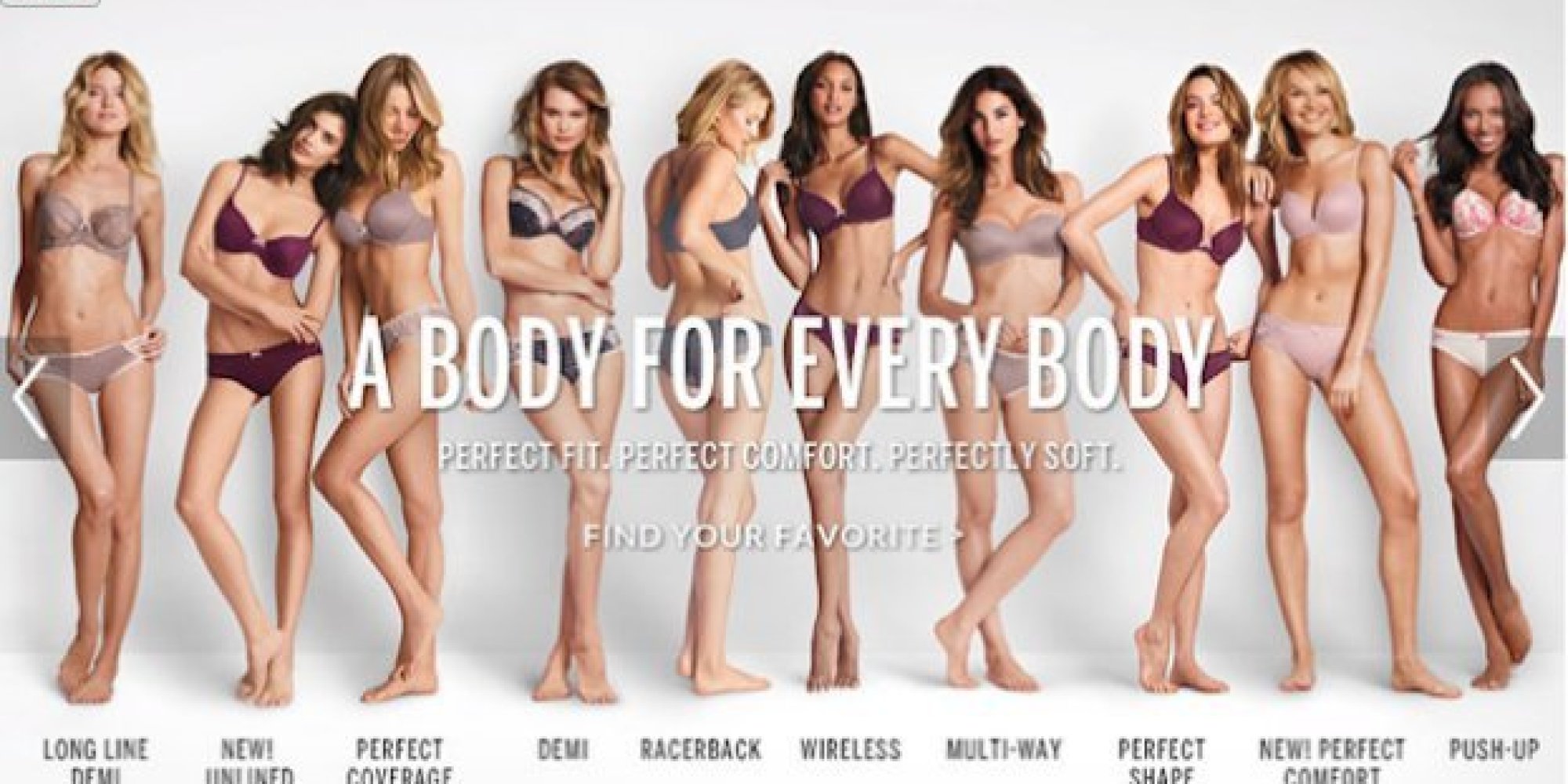In our current digital age, advertising surrounds our lives. Advertisements drive mass media by supporting over “60% of magazine and newspaper production and almost 100% of the electronic media” (Kilbourne 34). The information we receive, the websites we visit, the products we buy are all molded by advertisement. In our consumer culture, where identity, activity, and values are based on consumption of goods and services, advertisements can influence our choices whether we consciously perceive it or not. When advertisements bombard us with images of young, white, thin, sexualized women, they teach us to objectify bodies and an unhealthy image of beauty. Too often, media portrayal of women are destructive to perceptions of identity for women and men in America.
Representation of women is especially distorted through advertisement. Victoria’s secret is known for selling women’s undergarments, but the image of beauty is sold as well. Kimmel describes The Victoria’s Secret Fashion Show as “a two-hour-long commercial in which nearly naked models parade their own wares as well” (Kimmel 170). It’s as if the underwear merely accessorize the actual product: women’s bodies. Furthermore, Victoria’s Secret sells a homogenous brand of women in this advertisement. All ten women shown are tall and thin with distinct collar bones and visible rib cages. By setting a beauty standard that is unattainable by most women, self-esteem issues, eating disorders, depression all become side effects of media’s enormous influence. Too often we hear about how anorexia and bulimia affect girls during a time of vulnerable adolescence. Images of the one ideal body type presents an unhealthy attitude and desire towards a particular brand of physical beauty. In addition, this advertisement plays on overt sexualization. The models all have arched suggestive poses that flirt with the audience. Granted, this advertisement if for underwear, but the image of the seductive, objectified women is pervasive across media. Kimmel notes that, “guys and girls… are looking at sexualized images of women long before they’re even thinking about sex” (Kimmel 171). As a result, men are affected too when they are raised in a media culture teaching that thin, hour-glass figure women are so available and wanting. This illusion fosters the dangerous perception that forms a “toxic brew of entitlement and despair” to “vulnerable male identities” (Kimmel 172). How can a man respect a woman when the media dehumanizes her to a sex object wherever he turns to? Sex sells. Advertisers know that and for women, it “sends the message that their bodies are objects, and imperfect objects at that” (Kilbourne 27). When advertisements demean women this way, it’s dangerous to mental health and relationships within our culture. Girls grow up with a skewed sense of self-image and boys grow-up with a skewed perception of women. Furthermore, eight of the women have the same Caucasian skin tone. Racial diversity is very limited and unrepresentative of minorities. Even the black woman on the far-right has straight hair so it’s no mere coincidence that the advertisers intentionally avoided choosing a black woman with natural curly hair. Even the minorities that are represented in the advertisement are white-washed with general Caucasian features. This detail relates to the prevalence of white privilege in America, which Mcintosh outlines, “I… can see people of my race widely represented” as an example of privilege (Mcintosh 2). Therefore, this racial beauty standard in media representations alienates women of color as well. In a way, a form of censorship is at place through the “complete invisibility, of real women’s faces and bodies” (Kilbourne 51). The slogan in the advertisement could not be more inaccurate that there is ‘A Body for Every Body” when the models only represent one female beauty standard. The misrepresentation of women and beauty in media marginalize most women, minorities, and contribute to unhealthy perceptions. Women and men alike become victims to advertisers in our consumer culture unless we push for change.
When we go online shopping, to the movies, or open a magazine, individually, we may not devote much attention to an advertisement like above. However, this does not mean they have no effect on us. The images we see over and over normalize us hazardous ways of thinking in ways we may not consciously realize. Advertisers would not use white, thin, suggestive models if those tactics did not work. Kilbourne writes, “advertising’s power comes from the belief that advertising does not affect us” (Kilbourne 27). After all, we are most impressionable when we do not think critically.
Works Cited:
Kilbourne, Jean, and Mary Pipher. Can’t Buy My Love How Advertising Changes the Way We Think and
Feel. Free Press, 2012.
Kimmel, Michael S. Guyland the Perilous World Where Boys Become Men Harper, 2010.
McIntosh, Peggy. “White Privilege: Unpacking the invisible Backpack.” (1989).
